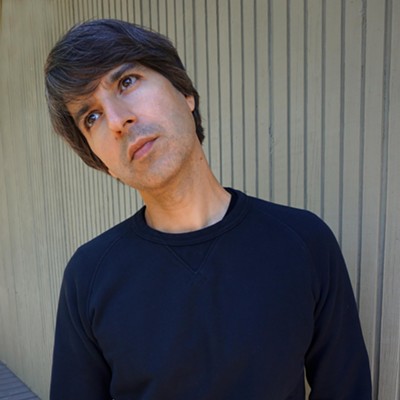"Last night, we saw these--what are those creatures called, these wild pigs?" Clute said. "They came right up to the house."
"We would never see something like that in San Francisco," Jennings added.
Double Vision, a San Francisco-based performance-art group that mixes dance, music, media and technology, is in Tucson for two collaborative shows with the Crossing Barriers Group, a performance-art group made up of UA musicians, dancers and artists.
Whatever happens at this weekend's shows will be the result of collaboration between these two improvisation-minded groups--and the Tucson environment is clearly influencing the visiting artists.
"I already feel like if I were to start making a work today, it would be totally different," Jennings said, with days remaining before their local shows.
So what will happen when these two mixed-media performance-art groups are put into a blender? Well, come see them this weekend to find out.
Crossing Barriers Group was formed about four years ago as an outlet for UA faculty members to improvise. Later, the group began incorporating different media, such as dance, said Patrick Neher, founding director of the Crossing Barriers Group and professor of music at the UA.
Neher met some Double Vision artists a few years ago at a University of Utah conference for art and technology. A pairing seemed like a natural fit, since similar philosophies exist between the groups. For example, both groups have sought to challenge the traditional paradigm of "I am the artist, and you are the audience."
Crossing Barriers Group has actually started performances in the audience--or even the lobby, Neher explained.
"We're trying to cross the barriers of ... the psychology of or the preconceptions the audience might have: 'I'm going to a classical concert or a classical dance performance. The thing opens; the performers come out and do their thing; the curtain closes, and we applaud.' Neher said. "There are all these protocols; I'm always testing those."
Like Crossing Barriers Group, Double Vision also incorporates the audience into their shows, for example, with "unstaged experiments" in warehouses and art galleries where the performer/audience border is breached.
With Double Vision on a five-week cross-country tour, the groups finally found an opportunity to work together. The unifying idea behind the show was developed long-distance through e-mailing and conference calls.
"This whole performance is oriented toward the idea of layering: layers of sound, layers of imagery, layers of motion," Neher said.
The performance will incorporate everything from 6-foot-by-8-foot interactive infrared screens to videos of single-celled spores set to music.
The interactive infrared screens, programmed by Double Vision co-director Sean Clute, respond to movement by dancers and trigger various responses, like playing a particular piece of music.
"Rather than pressing play on a CD player, the computers and the video all can adapt," Clute said. "A lot of time has been (spent) developing systems that work with the ensemble so that I can perform live with them, rather than sit behind a computer and check my e-mail."
The spore videos, shot by UA Professor Emeritus Dr. Neil Mendelson, show the spores replicating and twisting themselves into knots. They were colorized and given a soundtrack.
"These films are so anatomical-looking, they look like humans doing dance," Neher said, adding that he films can be used as inspiration for the dancers.
While portions of the performance have been substantially developed--such as the spore video piece and some of the music and dancing--organizers have left lots of room for adaptation, Jennings said.
"The people who are coming to the show are going to see and hear interesting art as it is being made," Jennings said. "... They're probably going to be privy to some artistic challenge and tension occurring on stage between these two different groups, which I think should be fascinating."
Who knows? Maybe there will even be some javelina references.
The UA School of Music presents the Crossing Barriers Group in concert with Double Vision at 7:30 p.m., Friday, Sept. 12, and 2 p.m., Saturday, Sept. 13, at the Stevie Eller Dance Theatre, 1713 E. University Blvd. The cost is $9 for general admission; $7 for UA employees and seniors; and $5 for students. Call 621-1162 for tickets or for more information. Additionally, a free, open-to-the-public workshop on the collaboration of media genres will be held at 12:30 p.m., Friday, Sept. 12, at the Stevie Eller Dance Theatre. For more details about the workshop, contact Patrick Neher at 621-5822.







